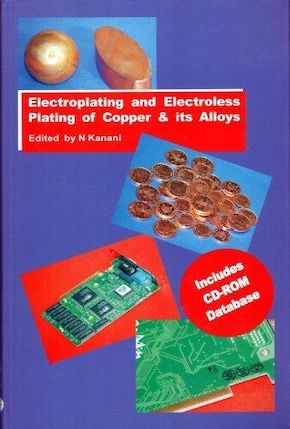
-----
How to Electroplate onto Polymers
Q. How do you electroplate a polymer? I have been asked to put down a thin metal coating on polymers by PVD methods so that they can be electroplated. I am curious about how most platers currently solve the non-conductance problem of polymers. Any and all comments are appreciated.

John Davis
- Berthoud, Colorado, USA
1998
A. Probably the most common approach is to electroless plate the material. The plastic is etched (usually in a very concentrated acid) to give the surface some bite, then immersed in palladium chloride and/or tin chloride to 'seed' the deposition process, then electroless nickel or electroless copper plated before electrolytic copper plating; additional plating can follow.
Invariably this is done with proprietary baths. Any of the suppliers can offer you a process. When done on polypropylene or ABS the adhesion can be astounding. In fact, most exterior brightwork on automobiles, such as grills, bezels and emblems, is plastic which has been plated in this fashion.
Years ago, interior items on automobiles (such as armrest brackets) were vacuum metallized by PVD processes. The quality and durability was about equivalent to the quality of the rings found in Cracker Jax boxes and gum ball machines, which were processed similarly. Later, a more durable vacuum metallizing process called "sputtering" was employed on exterior brightwork, and on plumbing fixtures.
A problem with electroplating onto plastic is that it is very waste intensive, and the wastes are toxic; if adequate adhesion onto the polymer in question can be achieved through PVD processes and thickness is sufficient without electroless plating, it is the way to go. Certainly, in general, there has been movement away from electroplating and towards PVD processes. A literature search will produce dozens of articles on the topic. Best of luck.

Ted Mooney, P.E.
Striving to live Aloha
finishing.com - Pine Beach, New Jersey
Ted is available for instant help
or longer-term assistance.
1998
1998
A. Any nonconductive body can be sensitized (tin chloride), activated (palladium chloride) and then immersed in a concentrated electroless nickel plating bath.
Warren Silverman1998
Q. Ted,
I recently discovered the letters section of the finishing.com website and must say I am very impressed. I'll probably going to join in many discussions in the future.
My first question is about your answer to this letter. Couldn't any nonconductive material be electroplated once it has been coated by a conductive material (e.g., silver or nickel ink)? What would the problems be in comparison to electroless plating?
Regards,
Oliver BuderA. Thanks for the kind words, Oliver. Yes, any nonconductive material could theoretically be plated once it has been coated with a conductive material. In terms of physically achieving plating onto the substrate, two issues come to mind: does the ink have sufficient current-carrying capacity for the next step in the process, and, does the ink impart sufficient chemical resistance that the part can be safely exposed to the plating chemistry.
In terms of functionality, something to remember is that proven electroless plating technologies can deliver phenomenal adhesion; sometimes it's very important for the plating to 'stick' despite severe thermal cycling and mechanical abuse like on exterior brightwork on automobiles. Also, there are many instances where the electrolessly plated coating is the final finish and there is no electroplated topcoat. A coating of electroless nickel can be robust in ways that a conductive ink probably can't be.
This is not at all meant to imply that conductive inks are not useful -- just that they cannot replace electroless plating in all applications.

Ted Mooney, P.E.
Striving to live Aloha
finishing.com - Pine Beach, New Jersey
Ted is available for instant help
or longer-term assistance.
1998
Q. Following on from the question about plating plastics, is there a well developed technique for masking areas of a plastic item from electroless plating? I'm keen to produce a couple of different surface finishes on a polyester film, including copper. I had in mind some easily deposited and removed "mask" that won't cost the earth or be a pollution nightmare.
Richard Jones- Manchester
2003
A. Masking technology has been part and parcel of the printed circuit board industry for years, Richard. You probably won't mask to prevent the electroless deposition though. Rather, you would probably electrolessly plate the whole thing, mask the areas you want to keep plated, etch away the non-masked area, remove the masking material, and finish the plating. See if you can find Coombs' Printed Circuits Handbook ⇦[this on Amazon affil links] and you may have the info, including the alternate approaches, that you need for your project. Good luck.

Ted Mooney, P.E.
Striving to live Aloha
finishing.com - Pine Beach, New Jersey
Ted is available for instant help
or longer-term assistance.
2003
Q. 2k moulding and partly plating for decorative reason... how is that possible? I would love to make decorative parts by 2k moulding if it's possible. Which materials get plated and which do not?
Klaus Mortenengineer - Denmark
February 6, 2008
A. Hi Klaus. Perhaps it possible to mold a conductive and a non-conductive plastic together and approach it from a different direction? But when we speak of traditional electroless plating, there is no "reaction" between the plastic and the plating solutions that distinguish what gets plated and what doesn't. Wherever the sensitizing and activating solutions are absorbed, those areas will plate. It may be possible to 2k mold ABS with another plastic that is fully resistant to the chromic-sulfuric acid that is used to etch the ABS so the sensitizing and activating won't "stick", but I'm not familiar with that. Sorry.
Regards,

Ted Mooney, P.E.
Striving to live Aloha
finishing.com - Pine Beach, New Jersey
Ted is available for instant help
or longer-term assistance.
December 2012
Q. I have already coated conducting material onto polymer thread by dipping. After dip coating it has decent conductivity. I need to add Cu on top of it. Would you please advice how can I do it.
Chaminda Jayasinghe- Cincinnati, Ohio
February 13, 2015
by N. Kanani

on eBay or Amazon
or AbeBooks
(affil link)
A. Hi Chaminda. Electroplating would probably be the most practical approach.
At the one extreme elementary school students can learn to do copper electroplating per our FAQ, "How Electroplating Works" in two minutes, while at the other extreme there are whole textbooks written just on copper plating .
A good compromise might be the Metal Finishing Guidebook which will explain the many different solutions for copper plating and their advantages & disadvantages, while also introducing you to the equipment considerations and the pretreatment & post-treatment steps. Good luck.
Regards,

Ted Mooney, P.E.
Striving to live Aloha
finishing.com - Pine Beach, New Jersey
Ted is available for instant help
or longer-term assistance.
February 2015
Q. Hello everyone,
I searched some papers and books about electroless plating. I also implemented all the steps mentioned under this topic. I have a micro-sized polypropylene sample. I prepared SnCl2 and PdCl2 solutions (HCl is included in PdCl2 solution). First I sensitized then activated with PdCl2. In the end I couldn't manage to plate any NiP on my part. If you can help me about the situation I will appreciate it. Thanks in advance.
Yildiz Technical University - ISTANBUL,TURKEY
July 9, 2015
A. Hi Yusuf. What, if anything, did you successfully plate your electroless nickel onto to prove that the EN plating solution itself works? :-)
Regards,

Ted Mooney, P.E. RET
Striving to live Aloha
finishing.com - Pine Beach, New Jersey
Ted is available for instant help
or longer-term assistance.
July 2015
Q. Yes Ted, I have managed to coat another polymer sample before. If you want I can share bath composition :)
Yusuf Kahraman [returning]Yildiz Technical University - Istanbul,TURKEY
July 13, 2015
A. Hi again Yusef. I was just trying to understand the possible areas where the problem could lie. As long as you are totally sure that your electroless nickel solution will work properly if the substrate is properly activated, then I guess it's appropriate to focus on what is wrong in the etching, sensitization or activation steps.
I am no plating on plastics expert, but I understand that Polypropylene is reputedly not impossible to metallize and electroplate but very difficult. How are you etching it or surface activating it (if you are).
Regards,

Ted Mooney, P.E. RET
Striving to live Aloha
finishing.com - Pine Beach, New Jersey
Ted is available for instant help
or longer-term assistance.
July 2015
Q, A, or Comment on THIS thread -or- Start a NEW Thread